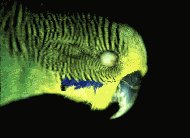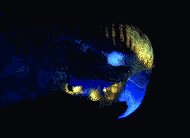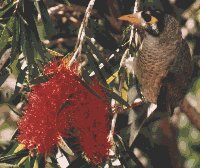Dr Kathryn Arnold - Research Interests
Dr Kathryn Arnold - Research Interests
Royal Society University Research Fellow
Dr Arnold is now based at The University of York - she moved there in April 2010.
For further information, please see her current profile page -
Maternal Effects
Maternal Effects
Reproduction is an expensive business. Mothers, in particular, put a lot of time and energy into making eggs and caring for young, at the expense of their own well being. I am investigating how mothers partition resources among young and how that affects the development and long term fitness of offspring. In birds, for example, mothers put substances into yolk that can influence the development of the egg. These include antioxidants, such as carotenoids (responsible for red and yellow colours in nature) and vitamin E, that enhance immune function and reduce the damage to organs caused by the build-up of harmful waste products. Parents also provide food to offspring. Selection of particular prey items might be vital for providing nutrients essential to normal growth. I am extremely interested in how neonatal nutrition affects the body systems involved in sexual signalling and ageing. For example, young that receive a poor quality diet during development, are they less attractive to the opposite sex as adults? Do they suffer more oxidative stress? Do their body age faster? We use a range of avian model species to investigate maternal effects.
Publications
Rutstein, A., Gorman, H., Arnold, K., Gilbert, L., Orr, K., Adam, A., Nager, R. G., and Gravers, J. 2005 Sex allocation in response to paternal attractiveness in the zebra finch Behavioral Ecology 16, 4, 763-769.
Gorman, H. E., Arnold, K. E., and Nager, R. G. 2005 Incubation effort in relation to male attractiveness in zebra finches Taeniopygia guttata. Journal Of Avian Biology 36, 5, 413-420.
Blount, J. D., Metcalfe, N. B., Arnold, K. E., Surai, P. F., Devevey, G. L., and Monaghan, P. 2003 Neonatal nutrition, adult antioxidant defences and sexual attractiveness in the zebra finch Proceedings Of The Royal Society Of London Series B-Biological Sciences 270, 1525, 1691-1696
Collaborators
Stephen Larcombe (PhD student), Division of Environmental and Evolutionary Biology, University of Glasgow
Dr Scot Ramsay (PDRA), Division of Environmental and Evolutionary Biology, University of Glasgow
Dr Ruedi Nager, Division of Environmental and Evolutionary Biology, University of Glasgow
Sexual Signalling and colour preferences in birds
Sexual Signalling and colour preferences in birds
Fluorescence is widely used by humans as a 'highlighter' to attract attention. Our research shows that Australian parrots use their fluorescent plumage, which literally 'glows', to attract the attention of the opposite sex.
My current research focuses on whether female budgerigars use fluorescence to evaluate male quality and whether this influences their subsequent investment in offspring.
In collaboration with Dr Lucille Alexander (Waltham), I will be supervising a new student starting a project on colour preferences in birds.
Collaborations
Dr. Justin Marshall, Vision, Touch & Hearing Research Centre, The University of Queensland
Dr. Ian Owens, Department of Biology and NERC Centre for Population Biology, Imperial College at Silwood Park, Ascot, Berkshire SL5 7PY, UK, Division of Environmental and Evolutionary Biology, University of Glasgow
a)  b)
b) 
a) Budgerigar (Melopsittacus undulatus) under normal illumination
b) Budgerigar under UV illumination - note the fluorescent yellow patches
Publications
Hausmann, F., Arnold, K. E., Marshall, N. J., and Owens, I. P. F. 2003. Ultraviolet signals in birds are special. Proceedings Of The Royal Society Of London Series B-Biological Sciences 270, 1510, 61-67.
Arnold, K. E., Owens, I. P., and Marshall, N. J. 2002. Fluorescent signaling in parrots. Science 295, 5552, 92.
Sex Allocation in Birds
Sex Allocation in Birds
Ongoing research focuses on sex allocation in birds and fish. This started as a BBSRC funded project with Richard Griffiths and David Houston. There is increasing evidence that female birds manipulate the sex of their offspring in response to environmental and social factors. We have been investigating when and how this is achieved, mainly using the zebra finch (Taeniopygia guttata) as a model.
Publications
Arnold, K. E., Orr, K. J., and Griffiths, R. 2003. Primary sex ratios in birds: problems with molecular sex identification of undeveloped eggs. Molecular Ecology 12, 12, 3451-3458.
Arnold, K. E., Adam, A., Orr, K. J., Griffiths, R., and Barber, I. 2003. Sex-specific survival and parasitism in three-spined sticklebacks: seasonal patterns revealed by molecular analysis. Journal Of Fish Biology 63, 4, 1046-1050.
Arnold, K. E., Griffiths, R., Stevens, D. J., Orr, K. J., Adam, A., and Houston, D. C. 2003. Subtle manipulation of egg sex ratio in birds. Proceedings Of The Royal Society Of London Series B-Biological Sciences 270, Suppl 2, S216-S219.
Arnold, K. E. and Griffiths, R. 2003. Sex-specific hatching order, growth rates and fledging success in jackdaws Corus monedula. Journal Of Avian Biology 34, 3, 275-281.
Arnold, K. E., Griffith, S. C., and Goldizen, A. W. 2001. Sex-biased hatching sequences in the cooperatively breeding Noisy Miner. Journal Of Avian Biology 32, 3, 219-223.
Kin Recognition in Fish
Kin Recognition in Fish
 One of my main interests is the evolution of sociality and group living. Essential to this is determining whether animals are able to recognise individuals, particularly those that they are related to. Living with relatives can be beneficial to individuals via the evolution of kin-directed altruism, but this is tempered by the increased risk of inbreeding. Therefore, in social species the ability to recognise relatives can be highly advantageous. This study focused on kin discrimination in the Lake Eacham rainbowfish, Melanotaenia eachamensis, an endangered freshwater species from NE Queensland, Australia. In 2006, I have a new collaborative project starting on kin recognition in cooperatively breeding cichlids.
One of my main interests is the evolution of sociality and group living. Essential to this is determining whether animals are able to recognise individuals, particularly those that they are related to. Living with relatives can be beneficial to individuals via the evolution of kin-directed altruism, but this is tempered by the increased risk of inbreeding. Therefore, in social species the ability to recognise relatives can be highly advantageous. This study focused on kin discrimination in the Lake Eacham rainbowfish, Melanotaenia eachamensis, an endangered freshwater species from NE Queensland, Australia. In 2006, I have a new collaborative project starting on kin recognition in cooperatively breeding cichlids.
Collaborators
Dr Barbara Mable, Institutue of Biodiversity, Animal Health & Comparative Medicine, University of Glasgow
Michael Taborsky, University of Berne, University of Glasgow
Cooperative Breeding in Birds
Cooperative Breeding in Birds
Co-operative breeding is characterised by individuals delaying or sharing their own breeding attempts and instead helping to rear the offspring of conspecifics. My research has examined variation in the incidence of co-operative breeding from the level of the order down to the individual.

The cooperatively breeding noisy miner (Manorina melanocephala) breeds in monogamous pairs with up to 22 male helpers assisting.
Using model approaches, we have been analysing the evolution of social behaviour and its impacts on life history.
Publications
Arnold, K. E., Owens, I. P. F., and Goldizen, A. 2005 Division of labour within cooperatively breeding groups Behaviour 142, 11-12, 1577-1590
Iwaniuk, A. N. and Arnold, K. E. 2004 Is cooperative breeding associated with bigger brains? A comparative test in the Corvida (Passeriformes) Ethology 110, 3, 203-220
Hardling, R., Kokko, H., and Arnold, K. E. 2003. Dynamics of the caring family. American Naturalist 161, 3, 395-412.
Arnold, K. E. 2000. Group mobbing behaviour and nest defence in a cooperatively breeding Australian bird. Ethology 106, 5, 385-393.
Arnold, K. E. 2000. Strategies of the cooperatively breeding noisy miner to reduce nest predation. Emu 100, PT4, 280-285.
Arnold, K. E. and Owens, I. P. F. 1999. Cooperative breeding in birds: the role of ecology. Behavioral Ecology 10, 5, 465-471.
Arnold, K. E. and Owens, I. P. F. 1998. Cooperative breeding in birds: a comparative test of the life history hypothesis. Proceedings Of The Royal Society Of London Series B-Biological Sciences 265, 1398, 739-745.
Collaborators
Dr. Anne Goldizen, Department of Zoology & Entomology, The University of Queensland
Dr. Ian Owens, Department of Biology and NERC Centre for Population Biology, Imperial College at Silwood Park, Ascot, Berkshire SL5 7PY, UK
Dr. Hanna Kokko, University of Helsinki
Roger Härdling, Evolutionary Population Biology, Dept of Animal Ecology, Lund University, Sweden

